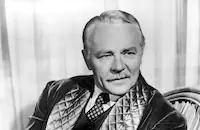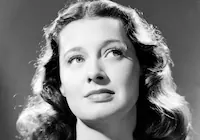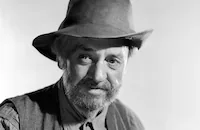The Parson of Panamint
Cast & Crew
William Mcgann
Charles Ruggles
Ellen Drew
Phillip Terry
Joseph Schildkraut
Porter Hall
Film Details
Technical Specs

Synopsis
Outside the ghost town of Panamint, California, oldtimer Chuckawalla Bill Redfield reminisces with a young prospector about the downfall of the town he founded: In the late 1800's, life changes in Panamint when Bill builds a church and goes to San Francisco to get a parson. When Bill gets involved in a barroom brawl, a young newly ordained parson, Reverend Philip Pharo, intercedes and prevents Bill from using his gun. Both Bill and Philip are arrested, and Bill realizes that this rough-and-tumble parson is just the person to guide the religious life of Panamint's citizens. The whole town turns out to welcome Philip into the parsonage, but banker Jonathon Randall and judge Arnold Mason immediately disapprove when Philip welcomes Crabapple Jones, a shiftless alcoholic, and Bob Deming and Mary Mallory, the saloon owner and his singer girl friend. Philip helps Crabapple reform by hiring him as his cook, and later, when Bill takes Philip into the gold mine, which is placed hazardously under a river, Philip urges Bill to insist that mine owner Randall get the water pump fixed for the safety of his workers. Although he is not religious, Bob is sympathetic to Philip's cause and allows him to make a speech in which he invites the drinkers and gamblers in Bob's saloon to church. The crowd is amiable until drunken Jake Waldren accuses dealer Chappie Ellerton of cheating him. Jake pulls his gun but accidentally shoots Mary, instead of Bob, who had tried to intervene. Jake escapes and goes into hiding, and Philip takes Mary into the parsonage to convalesce under the tender ministrations of his helper, Mrs. Tweedy. In spite of his help, Mary promises to come to church only when Bob does. On the night that Bob throws a banquet celebrating Mary's return, Philip brings Jake to the saloon. Bob is prepared to make good on his promise of vengeance but is forestalled by Mary who, under the guidance of Philip, forgives Jake. Later that night, Philip asks Chappie to change his sacreligious gaming banter, "Round she goes and round she goes and where she stops nobody knows but the Lord, and he won't tell," while Chappie tricks Philip into placing a bet on the roulette. Chappie refuses to change the verse and Philip wins so much money that Bob is forced to sign over the saloon to the reluctant parson. Shortly afterward Bob is shot in his office, and Mary knows that Chappie is the attacker, however, town elders later call his death a suicide. Philip leads a small group of mourners to the chapel. Randall and Mason, who have gotten a damning injunction against Philip, await them on the church steps and have locked the doors against them. Bill shoots the lock off the doors and the mourners proceed with their funeral. Although he is thrown out of church for practicing the brotherly love that he preaches, Philip holds prayer meetings in the saloon with the support of his remaining allies, Joaquin, a reformed thief and gunman, Crabapple, Mary and Bill. When he overhears Mary arguing with Chappie, who is becoming aggressive with her, Philip intervenes. Chappie pulls his gun and the parson, always ready to defend himself, struggles with him. Chappie falls and dies when he hits his head on a metal rod. Although Crabapple and Mary testify that it was an accidental death, Randall and Mason use this opportunity to get rid of Philip and discredit the witnesses by proving that Crabapple was drunk, and by forcing Mary to admit that she is in love with the parson. Philip is found guilty of murder, but his friends help him escape and hide him in Jake's cabin. Unknown to them, Jake sells the information of Philip's location to Randall and Mason, and also warns them of Bill's plan to hire a mine inspector because the water pump was never fixed. Randall and Mason incite the town into a lynch mob. While they are dragging Philip to the hanging tree, the river breaks through the mine. Bill prevents the hanging by making an impassioned speech in which he states that the greed of the people has destroyed the town, and that the mine is permanently closed and all the gold is lost. The mob disperses and Bill feels the weight of knowing he killed his own town. Back by the campfire, Bill recalls that Philip and Mary, who married, stayed in Panamint until the last person left, and he surmises that wherever they went, people were better just for having known the parson of Panamint.

Director
William Mcgann
Cast

Charles Ruggles

Ellen Drew

Phillip Terry

Joseph Schildkraut

Porter Hall

Henry Kolker

Janet Beecher

Clem Bevans

Douglas Fowley
Paul Hurst

Frank Puglia

Minor Watson
Harry Hayden

Russell Hicks
The Guardsmen Quartet
Crew
Ralph Berger
Sam Coslow
Russell Harlan
Thomas Hastings
Emile Kuri
John Leipold
Carrol Lewis
Frank Loesser
Ralph Merritt
Earl Moser
John Powers
Lewis J. Rachmil
Ralph Rainger
Ann Ronell
Sherman A. Rose
Adrian Scott
Harry Sherman
Manning Sherwin
John Sherwood
Harold Shumate
Irvin Talbot
James Thornton
Augustus Montague Toplady

Film Details
Technical Specs

Articles
Ellen Drew, 1914-2003
She was born Esther Loretta "Terry" Ray on November 23, 1914, in Kansas City, Missouri. The daughter of a barber, her family moved to Chicago when she was still an infant and she lived a very quiet childhood far removed from the glamour of Hollywood. She was encouraged by some friends to enter a beauty contest when she was just 17. After winning, she tried her luck in Hollywood, but found that they were no immediate offers for her particular talents.
She eventually took a waitressing job at C.C. Brown's, a famed Hollywood Boulevard soda fountain, and had virtually abandoned her dreams as a starlet when William Demarest, a popular actor's agent and well-known character actor, spotted her. Demarest arranged a screen test for her at Paramount, and she was promptly placed under contract for $50 a week.
For the first few years, (1936-38), Drew got only bit parts, and was often uncredited. When she finally got prominent billing in the Bing Crosby musical Sing You Sinners (1938), she decided to change her name, from Terry Ray to Ellen Drew. She earned her first major role in Frank Lloyd's If I Were King (1938) opposite Ronald Colman, yet for the most part of her career, rarely rose above "B" material and second leads. Still, she had some fine exceptions: Preston Sturges' enchanting comedy Christmas in July (1940), with Dick Powell; Tay Garnett's lighthearted war romp My Favorite Spy (1942) co-starring Kay Kyser; Julien Duvivier's taut The Imposter (1944), holding her own with a brooding Jean Gabin; and Mark Robson's chilling low-budget chiller Isle of the Dead (1945) opposite Boris Karloff. Drew made some notable television appearances in the late '50s including Perry Mason and The Barbara Stanwyck Show, before retiring from the entertainment industry. She is survived by her son David; five grandchildren; and five great-grandchildren.
by Michael T. Toole

Ellen Drew, 1914-2003
Quotes
Trivia
Notes
This film marked the first major screen role of actor Phillip Terry. Terry had had a number of small roles at M-G-M beginning in 1937. According to Hollywood Reporter news items, producer Harry Sherman considered directing this film, but Paramount eventually borrowed director William McGann from Warner Bros. Norman Kerry was cast, according to Hollywood Reporter, but his appearance in the final film has not been confirmed. Although the general release date was listed as June 27, 1941 in various release charts, Hollywood Reporter announced a world premiere in Salt Lake City, Utah, on July 10, 1941, and Film Daily Year Book lists August 22, 1941 as the film's release date. The discrepancy has not been further documented in news items. Hollywood Reporter news items also indicate that some scenes were filmed on location at the base of the Panamint Mountains in Death Valley, CA. Previous films based on Peter B. Kyne's short story were Pallas Pictures' 1916 The Parson of Panamint, directed by William D. Taylor and starring Dustin Farnum, and Famous Players-Lasky's 1922 While Satan Sleeps, directed by Joseph Henabery and starring Jack Holt (see AFI Catalog of Feature Films, 1911-20; F1.3362 and AFI Catalog of Feature Films, 1921-30; F2.6274).














